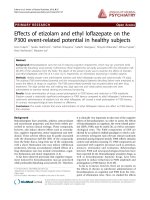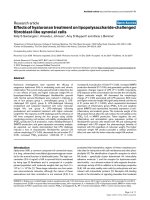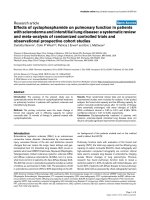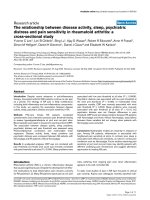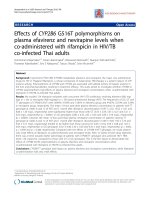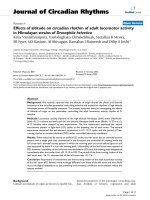Báo cáo y học: "Effects of lifestyle physical activity on perceived symptoms and physical function in adults with fibromyalgia: results of a randomized trial" pdf
Bạn đang xem bản rút gọn của tài liệu. Xem và tải ngay bản đầy đủ của tài liệu tại đây (447.76 KB, 9 trang )
RESEARC H ARTIC LE Open Access
Effects of lifestyle physical activity on perceived
symptoms and physical function in adults with
fibromyalgia: results of a randomized trial
Kevin R Fontaine
1*
, Lora Conn
1
, Daniel J Clauw
2
Abstract
Introduction: Although exercise is therapeutic for adults with fibromyalgia (FM), its symptoms often create
obstacles that discourage exercise. We evaluated the effects of accumulating at least 30 minute s of self-selected
lifestyle physical activity (LPA) on perceived physical function, pain, fatigue, body mass index, depression,
tenderness, and the six-minute walk test in adults with FM.
Methods: Eighty-four minimally active adults with FM were randomized to either LPA or a FM education control
(FME) group. LPA participants worked toward accumulating 30 minutes of self-selected moderate-intensity LPA, five
to seven days per week, while the FME participants received information and support.
Results: Seventy-three of the 84 participants (87%) completed the 12-week trial. The LPA group increased their
average daily steps by 54%. Compared to FME, the LPA group reported significantly less perceived functional
deficits (P = .032) and less pain (P = .006). There were no differences between the groups on the six- minute walk
test (P = .067), fatigue, depression, body mass index, or tenderness.
Conclusions: Accumulating 30 minutes of LPA throughout the day produces clinically relevant changes in
perceived physical function and pain in previously minimally active adults with FM.
Trial Registration: clinicaltrials.gov NCT00383084
Introduction
Fibr omyalgia (FM) is a chroni c, multi dimensional disor-
der characterized by persistent, widespread body pain
and tenderness [1]. FM is estimated to occur in 2% of
the U.S. general population, affecting about eight times
more women than men [2,3]. Sym ptoms associated with
FM include body pain, fatigue, sleep disruption, head-
ache, memory or concentration problems, mood distur-
bances, and irritable bowel syndrome [4]. FM often
substantially hampers day-to-day functioning and is a
primary cause of disability [5].
Even with the recent Food and Drug Administration
approval of medications to treat FM, pharmacotherapy
generally produces modest and inconsistent benefi ts on
symptoms, functioning, and quality of life [6]. As such,
nonpharmacologic treatments, such as exercise and
cognitive-behavioral interventions, are recommended to
assist people with FM to better manage the array of
symptoms and functional deficits [6]. Although exercise
has been shown to be beneficial [for example, [7]], the
symptoms of FM often create obstacles that deter many
from exercising consistently enough to derive benefits
[8]. Thus, finding new ways to promote increased physi-
cal activity in pe rsons with FM that can be sustained
overtime is important.
One promising approach is to ask people with FM to
increase their lifestyle physical activity (LPA). LPA
involves working toward meeting the U.S. Surgeon Gen-
eral’s 1996 Physical Activ ity Recommendations of accu-
mulating at least 30 minutes, above one’s usual activity,
of moderate-intensity physical activity five to seven days
a week by integrating short bouts of activity into the
day, such as increasing the amount of walking, perform-
ing more yard work, using the stairs and so on [9-11].
Although it is unclear whether a continuous 30 minute
* Correspondence:
1
Division of Rheumatology, Johns Hopkins University School of Medicine,
5200 Eastern Avenue, Baltimore, MD 21224, USA
Fontaine et al. Arthritis Research & Therapy 2010, 12:R55
/>© 2010 Font aine et al.; licensee BioMed Central Ltd. This is an open access art icle distributed under the terms of the Creative
Commons Attribution Lice nse ( which permits unr estricted us e, distribution, and
reproduction in any medium, provided the original work is properly cited.
bout of physical activity is superior to accumulating
smaller (10- to 15-minute) b outs of activity with regard
to health outcomes, asking people with FM to accumu-
late small bouts of physical activity throughout the day,
as opposed to b eing active for 30 consecutive minutes,
might be less taxing and therefore easier t o initiate and
sustain over time. In a pilot study [12], we found that
small bouts of LPA promoted a 70% incr ease in physical
activity in FM. However, in that small study LPA did
not produce significant benefits on pain, fatigue, or per-
ceived physical function compared to controls.
As part o f an on going randomized trial des igned to
investigate the effects of LPA on ambulatory reports of
physical activity, pain and fatigue, as well as measures of
fitness, pain threshold and pain tolerance, we also col-
lected questionnaire-based data on these variables. This
paper presents the results on questionnaire-based
asse ssmen ts of perceived physical function, pain, fatigue
and depression, as well as tenderness and aerobic endur-
ance after 12 weeks of LPA in minimally active adults
with FM.
Materials and methods
Participants
Participants were 92 adults (88 women and 4 men) aged
18 years or older who met American Col lege of Rheu-
matology diagnostic criteria for FM [13]. The mean
(SD) age of participants was 47.7 ± 10.7 years and 80%
were white. The mean duration of F M was 7.5 ± 6.2
years. At enrollment, participants were not meeting the
US Surgeon General’s 1996 recommendation for physi-
cal activity [11] for the previous six months (that is, not
engaging in either moderate-intensity physical activity
for ≥ 30 minutes on ≥ five days per week or vig orous
physical activity ≥ three times per week for ≥ 20 min-
utes each time during the previous month). Persons
with acute or chronic medical conditions that could pre-
clude active participation (for example, cancer, coronary
artery disease) were excluded from the trial. We also
excluded those who intended to change medications
that might affect mood, those who intended to seek pro-
fessional treatment for anxiety or depression during the
study period, and those who were unwilling to make the
required time commitment.
Participants were recruited from the Johns Hopkins
Arthritis Center, affiliated Johns Hopkins Rheumatology
clinics, by advertisements in the Arthritis Foundation
Maryland Chapter newsletter, newspaper advertise-
ments, and via clinical trial recruitment websites, includ-
ing clinicaltrials.gov. All pa rticipants completed baseline
testing which included a series of questionnaires, a ten-
der point examination, and a six-minute walk test. At
baseline, participants also wore a w aist-mounted ped-
omet er (AccuSplit Eagle 1020, Livermore, CA, USA) for
seven days (recalibrating it each morni ng) and r ecorded
their daily step count. These data were used to calculate
the mean steps per day as an estimate of physical activ-
ity. This st udy was approved by the Institutional Review
Board of Johns Hopkins University School of Medicine,
and all participants gave written informed consent.
Study procedures
Participants were randomized via a coi n flip at a 1:1
allocation ratio to each of the two groups. The group
meetings for LPA and FME were held on different days
to avoid contact between participants assigned to the
different conditions. The interventions did not replace
usual medical care and t he participants had comparable
durations of contact time with study staff (Table 1 sum-
marizes the LPA and FME conditions).
Lifestyle physical activity (LPA)
Participants assigned to LPA attended six, 60-minute
group sessions over 12 weeks. Delivered by one of the
authors (KRF), the LPA protocol was identical to the
one developed for our pilot study [12] and was loosely
based on Active Living Every Day, a cognitive-behavioral
physical activity promotion program developed by
Dr. Ste ven Blair and colleagues at the Cooper Ae robics
Center [14]. The LPA protocol addressed FM-specific
challenges to becoming more physically active (that is,
dealing with pain and fatigue, fear that physical activity
will promote a flare) and discussed how LPA success-
fully addresses them. The goal of the LPA intervention
was to i ncrease moderate-intensity physical activity by
helping participants find ways to accumulate short bouts
of physical activity throughout the day. Participants
were asked to gradually work their way up to meeting
the Surgeon General’ s 1996 recommendation of accu-
mulating 30 minutes, above usual activity, of moderate-
intensity LPA five to seven days each week.
At the first session, participants were taught how to
performtheirLPAatmoderate-intensity (that is, you
will be breathing heavily but not so heavily that you
could not hold a conversation). They were also pre-
scribed 15 minutes, above usual level, of accumulated
moderate-intensity LPA five to seven days a week, and
asked to increase the daily duration of LPA by five min-
utes each we ek. The five-minute increase in the daily
duration of LPA was based on findings fro m our pilot
study [12] and was well-tolerated by the majority of par-
ticipants. Thus, by Week 5, most participants were accu-
mulating 30 minutes, above their usual level, of LPA five
to seven days a week. Participants were free to accu mu-
late more than 30 minutes of LPA five to seven days per
week, if desired.
During subsequent sessions participants were taught
self-monitoring of LPA, goal setting, dealing with
Fontaine et al. Arthritis Research & Therapy 2010, 12:R55
/>Page 2 of 9
symptom flares, problem solving strategies to overcome
barriers to being more physically active, as well as
instruct ion in finding new ways to integrate short bouts
of LPA into their daily lives. Feedback focused on
whether participants achieved the prescribed level of
LPA, as well as the LPA’s influence on symptoms.
Participants wore the waist-mounted pedometers to
record their steps each day (that is, as an assessment of
adherence to LPA). Participants were shown how to use
the pedometer, where to place it, and how to record
their steps on a step diary form. At the end of each day
they recorded their steps on a diary form and zeroed
their pe dometer so they could record their steps for the
next day. They also kept a diary that categorized the
types of LPA’s they engaged in (for example, garden/
outdoor activity, household activity, leisure activity). The
step count data and diary entries were collected at each
intervention session.
Fibromyalgia education (FME)
Participants assigned to the FME group met monthly for
three months. FME was a minimal intervention with
each session divided i nto three components: (1) educa-
tion (45 to 60 m inutes), (2) question and answer (20 to
30 minutes), and (3) social support (20 to 30 minutes).
Conducted by an experienced FM support group facili-
tator, these 90- to 120-minute sessions presented infor-
mation on the symptoms, diagnosis, and treatment of
FM. The rationale for FME was to provide education
and to control for the effects of being enrolled in a clini-
cal trial and receiving increased attention and social
support. Moreover, by providing a minimal intervention,
as opposed to a standard care control, we anticipated
enhancing retention. The final session of FME presented
information on exercise and physical activity, but no
specific recommendations or prescription concerning
exercise was gi ven. To avoid t he possibility that wearing
a pedometer would increase their physical activity, FME
participants only wore one for the baseline and post-
testing assessments.
Outcomes measures
The following outcome measures were collected at base-
line and after the 12-week intervention.
Primary outcome
Perceived physical function
Perceived physical function was assessed using the
Fibromyalgia Impact Questionnaire (FIQ) total score.
The FIQ is a well-validated 10-item questionnaire that
measures aspects of physical functioning in patients
with FM [15]. The FIQ is scored so that h igher scores
are indicative of poorer functioning. Test-retest reliabil-
ity ranged from .56 to .95 and construct v alidity relative
to tender points was acceptable (rs = approximately .56)
[15].
Table 1 Description of lifestyle physical activity (LPA) and fibromyalgia education (FME) protocols*
Component LPA FME
Three, two-hour FM education and support meetings NO YES
Physical activity intervention delivered in six, one-hour meetings YES NO
Wear pedometer and keep a physical activity log YES NO
Prescribed physical activity YES NO
Approximately six hours of face-to-face contact time YES YES
Topics Covered During the Meetings
LPA FME
“Physical Activity & FM”
Described FM (symptoms, diagnosis, treatment)/benefits of physical activity/
demonstrated moderate-intensity LE/prescribed LE and self-monitoring/identified and
addressed barriers to physical activity
(Sessions 1 & 2)
“FM: What is it and how is it diagnosed?”
Presented general information on the symptoms of
FM and how it is diagnosed;
Discussion and social gathering
(Session 1)
“How to Keep Moving”
Discussed progress, effect on symptoms, goal setting, problem solving, importance of
self-monitoring, provided feedback, and troubleshooting
(Sessions 3 & 4)
“What causes FM?”
Presented the latest information on the causes and
consequences of FM;
Discussion and social gathering
(Session 2)
“Now It’s Up To You”
Planned for setbacks & developed strategies to overcome them, set long-term goals,
self-monitoring over the long-term
(Sessions 5 & 6)
“Treating FM”
Discussed of medical and non-medical approaches,
including exercise, to treating FM;
Discussion and social gathering
(Session 3)
LPA
Accumulate ≥ 30 minutes of self-selected physical activity five to seven days per week
FME
Did not alter their characteristic level of physical
activity
*FM, fibromyalgia; FME = fibromyalgia education; LPA, lifestyle physical activity
Fontaine et al. Arthritis Research & Therapy 2010, 12:R55
/>Page 3 of 9
Secondary outcomes
Pain
Pain was assessed using a 100 mm Visual Analogue
Scale (VAS) where participants rated their current level
of pain, ranging from 0 (no pain) to 100 (worse pain
imaginable).
Fatigue
The Fatigue Severity Scale (FSS) [16] was used to assess
the current level of fatigue. The FSS is a nine-item ques-
tionnaire, answered on a seven-point scale, ranging from
strongly agree to strongly disagree.TheFSShasgood
internal consistency (Cronbach ’s alpha = .81) and corre-
lates with VAS fatigue measures (r = .68) [16].
Depression
Depression was assessed using the Center for Epidemio-
logic Studies Depression Scale (CES-D) [17]. The CES-D
contains 20-items rated on a four-point Likert scale ran-
ging from 0 (rarely o r none of the time) to 3 (most or
all of the time), and measures symptoms during the past
week. The CES-D is a widely used measure of depressive
symptoms and has acceptable internal consistency (.84
to .90) and validity (r = .56 with clinical rating of
depression severity) [17].
Tenderness
A digital tender point examination, at the 18 sites speci-
fied in the American College of Rheumatology FM clas-
sification criteria [13], was completed at baseline and
after the intervention. Tender point counts are moder-
ately reliable in classifying the tenderness associated
with FM (kappa = .75) and inter-rater agreement on the
presence of tenderness through digital examination is
.51 [13].
Body mass index (BMI: kg/m
2
)
Weight and height were recorded at each assessment
and these variables were used to calculate BMI, an
index of body weight adjusted for height.
Six-minute walk test
The six-minute walk [18] is a measure of aerobic endur-
ance. For this test, participants walked as far they could
in six minutes on a preselected course, with the distance
walked recorded. The reliability of the six-minut e walk
test is excellent (r = .91) and it correlates with the FIQ
(r = 49) and is sensitive to change due to exercise in
distance walked (+78 m), and VO
2
(+1.8 ml/kg/min)
[18]. The six-minute walk test was measured at baseline
and at post-testing. We expressed the results as meters
per second, an index of gait speed.
Sample size and data analysis
Thirty-five adults with FM per group were projected to
provid e a power of 80% to d etect a clinically significant
20% difference between the groups on the FIQ score.
Ninety-two participants were enrolled to allow for a
25% post-randomization drop out rate.
Baseline data between the two groups were compared
using t-tests or Chi Square tests. Changes in perceived
physical function, depression, pain, tenderness, fatigue,
BMI, and the six-minut e walk test were compared
between the LPA and FME groups using between-sub-
jects t-tests. Because there was a significant difference
between the LPA and FME groups on self-reported
duration of FM (see Table 2), as a sensitivity analysis,
we adjusted scores of the outcome measures for the
duration of FM and replicated the analyses. We also
used regression techniques to adjust the outcome mea-
sures on the basis of w hether or not the participant
reported any change in their ongoing FM treatments,
either pharmacologic or non-pharmacologic (0 = no
change, 1 = change) during the trial. Because the results
did not differ as a function of these adjustments, we
present the results for the unadjusted outcome variables.
Although data from all subjects were analyzed regardless
of whether those subjects complied with or remained in
treatment, participants with missing data on a particular
variable were excluded from that particular analysis. We
also performed an analysis among participants who
completed the 12-week trial (completers only). Cohen’s d
effects size estimates [19] were calculated for each dif-
ference on the outcome measures between LPA and
FME. Analyses were performed using SPSS software,
Version 16. Two-tailed P values of < 0.05 were used to
denote statistical significance.
Results
Nine participants withdrew after baseline testing but
prior to randomization (see Figure 1). We randomized
46 participants into the LPA intervention and 38 into
the FME group in five separate cohorts of approximately
8 to 10 per cohort at six-month intervals. (Because the
FME facilitator was unavailable, one smaller cohort
(N = 4) was comprised of o nly LPA participants).
Selected baseline characteristics of the 84 participants
are shown in Table 2. With the exception of duration of
FM, the two groups were comparable on age, race, edu-
cation, employment status, BMI, and the use of medica-
tions for FM or for other medical conditions.
Seventy-three of the 84 participants (87%) completed
the 12-week intervention and post-testing. Drop outs
were unrelated to randomized treatment assignment
(P = .988) and there were no significant differences on
any baseline variables between those who dropped out
and those who completed post-testing. There was also
no difference in the mean percentage of meetings
attended by those randomized to the FME (77%) and
LPA (72%) groups (P = .542).
AsshowninFigure2,theLPAgroupsignificantly
increased the mean number of daily steps from 3,788 ±
2,135 at baseline to 5,837 ± 1,770 at the final
Fontaine et al. Arthritis Research & Therapy 2010, 12:R55
/>Page 4 of 9
intervention session (P = .001). This represents a 54%
increase in the mean number of daily steps over the
course of the 12-week in tervention. Although walking
was the most common form of LPA, other popular
forms of LPA included garden/outdoor activity (for
example, mowing the lawn, planting flowers, pulling
weeds); household activity (for example, cleaning out a
closet, vacuuming, doing laundry); and sports activity
(for example, cycling, swimming, field hockey).
At baseline, there were no significant differ ences
between the LPA and FME groups on FIQ, pain, fatigue,
depression, number of tender points, BMI, and six-min-
ute walk distance (see Table 3). At post-testing, com-
pared to the FME group, the LPA group reported
significant reductions in the FIQ score (P = .032; Cohen’s
d = .53) and in pain (P =.006;Cohen’s d =.67).Thedif-
ference between the LPA and FME groups on the six-
minute walk test approached significance (P = .067;
Cohen’ s d = .53). T here were no significant differences
between the groups on BMI, fatigue, depression, or the
number of tender points. The results (data not shown)
were not mater ially alter ed when the an alysis was
restricted to only participants who completed the entire
12-week trial (that is, completers only analysis).
Discussion
The 12-week program, designed to help minimally
active adults with FM increase their physical activity by
working toward accumulating at least 30 minutes of
self-selected moderate-intensity physical activity most
days of the week, produced a 54% increase in the aver-
age number of steps taken per day. Compared to the
FME control group, LPA part icipants significantly
reduced their perceived functional deficits (that is, FIQ
score) and pain. Moreover, compared to FME, the LPA
participants had a greater improvement on the six-min-
ute walk (expressed as gait speed), although this differ-
ence failed to reach statistical significance. The
magnitude of the post-intervention differences,
expressed as percent change from LPA to FME groups,
were 18% for the FIQ score and 35% for the pain VAS
score. When expressed as Cohen’s d effect sizes these
are indicative of medium-sized effects. Moreover, the
change on the FIQ score exceeds the minimally clini-
cally important difference of 14% recently identified
[20], suggesting that increasing physical activity via LPA
produces changes on perceived physical function that
are of a relevant magnitude. On the other hand, the
effect of LPA on the six-minute walk test was not
Table 2 Baseline characteristics of the randomized participants*
Characteristic Lifestyle Physical Activity (LPA) Fibromyalgia Education
(FME)
P value
N (%) of participants 46 (55) 38 (45)
Age, years 46.4 ± 11.6 49.0 ± 10.2 0.287
Female, N (%) 43 (94) 38 (100) 0.248
Self-reported race, N (%) 0.789
White 36 (78) 31 (82)
Non-White 10 (22) 7 (18)
Marital status, N (%) 0.519
Married or cohabitating 24 (52) 24 (63)
Widowed, divorced, or separated 12 (27) 11 (29)
Single 10 (22) 3 (8)
Educational level, N (%) 0.454
Postgraduate 9 (20) 5 (13)
College graduate 16 (34) 11 (32)
Some college 11 (24) 13 (34)
High school 10 (22) 8 (21)
Employment status, N (%) 0.923
Employed 20 (43) 18 (47)
Unemployed or Disabled 11 (24) 9 (24)
Retired or Other 15 (33) 11 (29)
Years since diagnosis
a
5.9 ± 5.1 9.6 ± 6.8 0.007
Steps per day 3,788 ± 2,135 3,071 ± 1,810 0.139
Taking FM medications, N (%)
a
31 (82) 40 (87) 0.498
Taking other medications, N (%)
a
33 (87) 44 (96) 0.146
*Data for categorical variables are presented as N’ and percentages; data for continuous variables are presented as means ± standard deviation.
a
Obtained from self-report.
FME, fibromyalgia education; LPA, lifestyle physical activity
Fontaine et al. Arthritis Research & Therapy 2010, 12:R55
/>Page 5 of 9
Figure 1 Participant flow.
Figure 2 Average steps per day (with 95% confidence interval) for the study groups.
Fontaine et al. Arthritis Research & Therapy 2010, 12:R55
/>Page 6 of 9
statistically significant (although it produced a Cohen’s
d of .53). It is important to note that there was a smaller
sample size available for this analysis which reduced sta-
tistical power.
In general our results are in accord with studies inves-
tigating the effects of exercise on people with FM
[7,8,21,22]. Specifically, the majority of studies suggest
that exercise can produce mild-to-moderate benefits on
aerobic endurance, strength, functional status, and qual-
ity of life [7,23,24]. However, because the exercise inter-
ventions investigated vary so markedly in type (for
example, water aerobics, traditional aerobics, T’ ai Chi,
strength training), frequency, intensity, and duration it is
difficult to compare results across studies.
One thing seems clear from the FM exercise literature,
people with FM have difficulty adhering to exercise.
Indeed, in FM clinical exercise trials drop-out rates
often nearly exceed 30% [for example, [8,24]] suggesti ng
that developing exercise interventions that can be sus-
tained is perhaps as important a goal as finding the par-
ticular interventions that produce optimal benefits.
The magnitude of the effect s of LPA observed in this
study on perceived physical function and pain were
similar to those obtained in our smaller pilot study [12].
These effects were also generally consistent with other
protocols that involve low-to-moderate intensity exer-
cise, interventions that appear to produce t he greatest
level of compliance in people with FM [for example,
[7,8,24]].
It is important to note that even though the LPA
group increased their mean daily steps by 54%, it only
moved them, as defined by the pedometer-determ ined
physical activity classifications developed by Tudor-
Locke and colleagues [25], from the sedentary (<5,000
Table 3 Differences between lifestyle physical activity (LPA) and fibromyalgia education (FME) groups on the primary
and secondary study measures
a
Variable Mean ± SD Mean difference between groups at baseline and at 12-weeks
(95% CI)
P
Value
Cohen’s
d
N LPA FME
FM impact questionnaire
Baseline 84 67.5 ±
12.0
69.7 ±
13.4
2.2 (-3.3 to 7.8) 0.424 .17
Post intervention 73 56.7 ±
20.6
67.0 ±
18.6
10.2 (.91 to 19.6) 0.032 .53
Pain
Baseline 84 54.6 ±
25.6
58.9 ±
25.0
4.3 (-7.2 to 14.9) 0.489 .17
Post intervention 73 46.3 ±
24.2
62.4 ±
24.5
16.1 (4.6 to 27.5) 0.006 .67
Fatigue severity scale
Baseline 84 51.9 ± 9.3 52.3 ± 9.1 .4 (-3.6 to 4.4) 0.843 .04
Post intervention 73 50.6 ± 9.9 51.4 ±
10.1
.8 (-3.9 to 5.5) 0.727 .07
CES-D*
Baseline 84 23.4 ± 8.6 24.0 ± 10 .6 (-3.8 to 4.5) 0.798 .06
Post intervention 73 21.6 ± 9.8 21.2 ±
11.3
.4 (-5.3 to 4.6) 0.888 .04
Number of tender points
Baseline 84 16.2 ± 2.3 16.1 ± 3.2 .1 (-1.2 to 1.0) 0.979 .03
Post intervention 72 16.0 ± 2.3 16.8 ± 2.0 .8 ( 35 to 1.9) 0.172 .37
Body mass index (BMI)
Baseline 82 31.4 ± 8.4 29.8 ± 6.2 1.6 (-4.7 to 1.7) 0.360 .22
Post intervention 60 31.0 ± 9.0 29.9 ± 6.2 1.1 (-5.3 to 2.9) 0.575 .14
Six-minute walk test, yd/
sec
Baseline 77 1.08 ±
0.15
1.08 ±
0.19
.0004 (-0.78 to 0.79) 0.991 0
Post intervention 62 1.24 ±
0.28
1.11 ±
0.20
1.21 (-0.25 to 0.008) 0.067 .53
*Center for Epidemiologic Studies Depression Scale;
a
between-subjects t-tests were used to derive P values;
b
Cohen’s d [19] effect size estimates (d = .20 (small
effect); d = .50 (medium effect); d = .80 (large effect)).
FME, fibromyalgia education; LPA, lifestyle physical activity
Fontaine et al. Arthritis Research & Therapy 2010, 12:R55
/>Page 7 of 9
steps/day) to the low active (5,000 to 7,499 steps/day)
category. Indeed, the mean step s per day at post-testing
among the LPA participants were comparable to the
mean daily steps observed in patients with progressive
neuromuscular disease , and are significantly lower than
other special populations such as diabetics, patients
undergoing breast cancer treatment, and those with
jointreplacements[26].Thissuggeststhat,evenwith
the initiation of LPA, people with FM progress only to a
relati vely low level of physical activity. It is important to
note, however, that the trajectory of the mean step
count continued to rise over the 12 weeks suggesting
that, had the trial continued, their physical activity may
have continued to i ncrease. It may be that people with
FM require more time t o eventually reach physical
activity recommendations compared to persons with
other chronic conditions.
This study has limitations and strengths. First, to
minimize attrition and control for the effects of
increased attention, participants randomized to the FME
group did receive a minimal intervention. Thus, we can-
not determine h ow LPA c ompares with a traditional no
treatment control group. Second, with the exception of
BMI, the tender point count and six-minute walk test,
the outcomes described herein were derived from self-
report and may be influenced by a variety of factors,
including those associated with enroll ment in a clinical
trial . Third, using pedo meters to assess LPA is relatively
crude and does not quantify o ther sorts of physical
activities that participants may have engaged in such as
cycling or water exercise. Fourth, we did not me asure
muscle strength during the trial so we are unable to
determine whether LPA influences strength. Finally, we
excluded persons with FM who had other co-morbid
conditions such as uncontrolled hypertension or arthritis
which may limit the generalizability of our findings.
Strengths of this study include the randomized design, a
relatively small drop-out rate (13%), the LPA group’ s
adherence to standardized intervention protocol, and
the relatively high rates of attendance to the group
sessions.
Conclusions
The results of this study suggest that promoting
increased physical activity by asking persons with FM to
accumulate short bouts of activity throughout the day
can markedly increase the average number of steps
taken per day and produces clinically relevant reduc-
tions in perceived functional deficits and pain. However,
the LPA intervention only moved the participants from
the sedentary to low physical activity category. This sug-
gests that it is essential to encourage FM patients to
increase the duration of their physical activity in ways
that do not com promise their ability to sustain the
increased level of activity over the intermediate- and
long-term.
Abbreviations
BMI: Body Mass Index; CES-D: Center for Epidemiologic Studies Depression
Scale; FIQ: Fibromyalgia Impact Questionnaire; FM: fibromyalgia; FME:
Fibromyalgia Education Control Group; FSS: Fatigue Severity Scale; LPA:
lifestyle physical activity; SD: standard deviation; VAS: Visual Analogue Scale.
Acknowledgements
Grant support: NIH/NIAMS grant AR053168. The funding body played no
role in the study design; in the collection, analysis, and interpretation of
data; in the writing of the manuscript; and in the decision to submit the
manuscript for publication. We also acknowledge the support of the Johns
Hopkins Bayview Clinical Research Unit for assistance with data collection.
Author details
1
Division of Rheumatology, Johns Hopkins University School of Medicine,
5200 Eastern Avenue, Baltimore, MD 21224, USA.
2
Departments of
Anesthesiology and Medicine (Rheumatology), University of Michigan,
Chronic Pain & Fatigue Research Center, 24 Frank Lloyd Wright Lobby M,
Ann Arbor, MI 48106, USA.
Authors’ contributions
KF conceived of the study, acquired the funding, participated in the design
of the study, the delivery of the intervention, performed the statistical
analysis, and drafted the manuscript. LC carried out the recruitment,
enrollment, and data collection. DC participated in designing the study and
assisted with the drafting of the manuscript. All authors read and approved
the final manuscript.
Competing interests
Kevin R. Fontaine and Lora Conn declare that they have no competing
interests. Daniel J. Clauw has acted as a consultant for Pfizer, Lilly, Forest
Laboratories, Cypress Biosciences, Pierre Fabre, UCB, and Wyeth, and has
received grant support from Pfizer, Cypress Bioscience, and Forest.
Received: 26 October 2009 Revised: 4 February 2010
Accepted: 30 March 2010 Published: 30 March 2010
References
1. Perrot S, Dickenson AH, Bennett RM: Fibromyalgia: Harmonizing science
with clinical practice considerations. Pain Pract 2008, 8:177-189.
2. Lawrence RC, Felson DT, Helmick CG, Arnold LM, Choi H, Deyo RA,
Gabriel S, Hirsch R, Hochberg MC, Hunder GG, Jordan JM, Katz JN,
Kremers HM, Wolfe F: Estimates of the Prevalence of Arthritis and Other
Rheumatic Conditions in the United States Part II. Arthritis Rheum 2008,
58:26-35.
3. Marcus DA: Fibromyalgia diagnosis and treatment options. Gend Med
2009, Suppl 2:139-151.
4. Williams DA, Clauw DJ: Understanding fibromyalgia: Lessons from the
broader pain research community. J Pain 2009, 10:777-791.
5. Goldenberg DL, Burckhardt C, Crofford L: Management of fibromyalgia
syndrome. JAMA 2004, 292:2388-2385.
6. Gore M, Sadosky AB, Zlatera G, Clauw DJ: Clinical characteristics,
pharmacotherapy and healthcare resource use amongpatients with
fibromyalgia newly prescribed gabapentin or pregabalin. Pain Pract 2009,
9:363-374.
7. Busch AJ, Schacter CL, Overend TJ, Peloso PM, Barber A: Exercise for
fibromyalgia: a systematic review. J Rheum 2008, 35:1130-1144.
8. Jones KD, Liptan GL: Exercise Interventions in Fibromyalgia: Clinical
Applications from the Evidence. Rheum Dis Clin North Am 2009,
35:373-391.
9. Dunn AL, Marcus BH, Kampert JB, Garcia ME, Kohl HW III, Blair SN:
Comparison of lifestyle and structured interventions to increase physical
activity and cardiorespiratory fitness. JAMA 1999, 281:327-334.
10. Plonczynski DJ, Wilbur JE, Larson JL, Keith TK: Lifestyle Physical Activity of
Older Rural Women. Res Nurs Health 2008, 31:501-513.
Fontaine et al. Arthritis Research & Therapy 2010, 12:R55
/>Page 8 of 9
11. U.S. Department of Health and Human Services: Physical Activity and Health:
A Report of the Surgeon General Centers for Disease Control and Prevention
(CDC), National Center for Chronic Disease Prevention and Health
Promotion, Atlanta 1996.
12. Fontaine KR, Haaz S: Effects of lifestyle physical activity on health status,
pain, and function in adults with fibromyalgia syndrome. J Musculoskel
Pain 2007, 15:3-9.
13. Wolfe F, Smythe HA, Yunus MB, Bennett RM, Bombardier C, Goldenberg DL,
Tugwell P, Campbell SM, Abeles M, Clark P, Fam AG, Farber SJ, Fiechtner JJ,
Franklin CM, Gatter RA, Hamaty D, Lessard J, Lichbroun AS, Masi AT,
Mccain GA, Reynolds WJ, Romano TJ, Russell IJ, Sheon RP: The American
College of Rheumatology 1990 Criteria for the Classification of
Fibromyalgia. Report of the Multicenter Criteria Committee. Arthritis
Rheum 1990, 33:160-172.
14. Blair SN, Dunn AL, Marcus BH, Carpenter RN, Jaret P: Active Living Every Day
Champaign: Human Kinetics 2002.
15. Burckhardt CS, Clark SR, Bennett RM: The fibromyalgia impact
questionnaire: Development and validation. J Rheum 1991, 18:728-733.
16. Krupp LB, LaRocca NG, Muir-Nash J, Steinberg AD: The fatigue severity
scale: application to patients with multiple sclerosis and systemic lupus
erythematosus. Arch Neurol 1989, 46:1121-23.
17. Radloff LS: The CES-D Scale: a self-report depression scale for research in
the general population. Appl Psychol Meas 1977, 1:385-401.
18. Pankoff B, Overend T, Lucy D, White K: Validity and responsiveness of the
6 minute walk test for people with fibromyalgia. J Rheum 2000,
27:2666-2670.
19. Cohen J: Statistical Power Analysis for the Behavioral Sciences Hillsdale:
Erlbaum, 2 1988.
20. Bennett RM, Bushmakin AG, Cappelleri JC, Zlateva G, Sadosky AB: Minimally
clinically important difference in the Fibromyalgia Impact Questionnaire.
J Rheum 2009, 36:1304-1311.
21. Goldenberg DL: Multidimensional modalities in the treatment of
fibromyalgia. J Clin Psychiatry 2008, 69:30-34.
22. Rooks DS, Gautim S, Romeling M, Cross ML, Stratigakis D, Evans B,
Goldenberg DL, Iversen MD, Katz JN: Group exercise, education, and
combination self-management in women with fibromyalgia. Arch Intern
Med 2007, 167:2192-2200.
23. Nørregaard J, Lykkegaard J, Mehlsen J, Danneskiold-Samsøe B: Exercise
training in treatment of fibromyalgia. J Musculoskel Pain 1997, 5:71-79.
24. Jones KD, Burckhardt CS, Clark SR, Bennett RM, Potempa KM: A randomized
controlled trial of muscle strengthening versus flexibility training in
fibromyalgia. J Rheumatol 2002, 29:1041-1048.
25. Tudor-Locke C, Hatano Y, Pangrazi RP, Kang M: Revisiting “how many
steps are enough?”
Med Sci Sports Exerc 2008, 40:S537-543.
26. Tudor-Locke C, Washington TL, Hart TL: Expected values for steps per day
in special populations. Prev Med 2009, 49:3-11.
doi:10.1186/ar2967
Cite this article as: Fontaine et al.: Effects of lifestyle physical activity on
perceived symptoms and physical function in adults with fibromyalgia:
results of a randomized trial. Arthritis Research & Therapy 2010 12:R55.
Submit your next manuscript to BioMed Central
and take full advantage of:
• Convenient online submission
• Thorough peer review
• No space constraints or color figure charges
• Immediate publication on acceptance
• Inclusion in PubMed, CAS, Scopus and Google Scholar
• Research which is freely available for redistribution
Submit your manuscript at
www.biomedcentral.com/submit
Fontaine et al. Arthritis Research & Therapy 2010, 12:R55
/>Page 9 of 9

